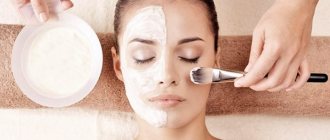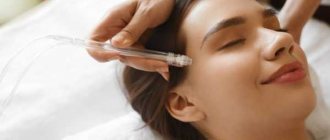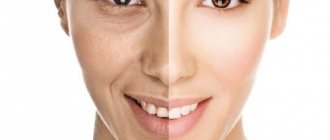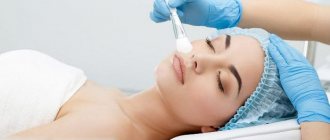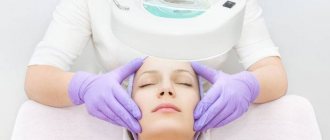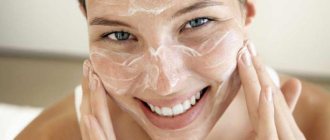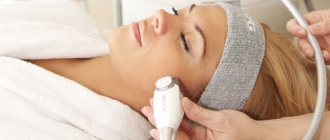What it is?
Coral peeling appeared on the cosmetic services market several years ago, but has already established itself as an extremely effective facial cleanser.
This method of skin cleansing refers to abrasive or mechanical methods. However, experts clarify that thanks to the main and additional components, the cleansing procedure using coral peeling is a combination of mechanical and light chemical effects on the skin. The product has a complex composition, including only natural ingredients:
- minerals, proteins, plant acids, vitamins C and E contained in grains of coral;
- Brazilian herbs;
- essential oils;
- Dead Sea salt.
The exfoliating effect is exerted by small particles of corals growing in the Red Sea.
A rich complex of additional substances enhances the effect of the procedure and ensures high-quality results:
- plant acids accelerate the process of skin regeneration;
- minerals and salt saturate the skin with essential microelements at the cellular level;
- herbs have an anti-allergenic and antiseptic effect, eliminating the risk of inflammation;
- oils nourish tissues and give them elasticity.
A product based on coral cleanses the skin at the surface and middle levels. The depth of cleaning depends on the amount of composition and the time of rubbing it into the skin.
Professional cosmetology clinics and salons position it as a gentle alternative to similar chemical procedures, the harshness of which is not suitable for everyone. The end result is comparable to methods such as microdermabrasion and glycolic peeling. At the same time, the use of a coral preparation is recognized by experts as one of the most gentle ways to deep cleanse the skin.
In practice, the professional line Rose de Mer, produced by the Israeli company Christina, is most often used.
Coral Perfection
Coral peeling is a mechanical peeling and an excellent alternative to harsh chemical peels used in cosmetology. It is absolutely safe for the skin as it contains natural coral ingredients and only 1% glycolic acid. In addition to the procedure of exfoliating and cleansing the skin, coral peeling easily copes with the elimination of pigmentation, acne and scars.
As a rule, after the first treatment of the skin with this type of peeling, the exfoliation of the skin will continue for one week, and noticeable improvements and excellent results will appear after six sessions of coral peeling.
The main difference between coral peeling and others is the abrasive particles in its composition, while other peelings mostly consist of acids and auxiliary substances. And due to the fact that it contains a minimal amount of acid, it has a completely different effect on the skin.
Possibilities of coral peeling
The most important thing is an effective exfoliating effect. It is the components included in coral peeling that soften the surface layer of the skin and promote enhanced cleansing of a certain area. All treated areas of the skin subsequently receive restorative components that have a beneficial effect on the skin, nourishing and protecting it. Gradually, the surface of the skin is leveled and tightened. And in areas of the skin exposed to mechanical coral peeling, the process of skin regeneration starts.
Of course, someone will probably prefer the effect on the skin of various scrubs that also contain abrasive particles. Today they are offered for sale in sufficient quantities or you can even make them yourself, but there is a difference here and it is noticeable. Coral peeling has a milder effect, does not expose the skin to wounds and other damage invisible to the unprofessional eye, and does not dry out the skin.
By the way, on our website facesave.ru you can find out everything about carbon peeling for the face.
Useful composition
Today, cosmetology clinics and salons have a lot of products for carrying out peeling procedures, however, most certified cosmetologists are inclined to use the Israeli line of Rose de Mer peelings in their work, which have proven themselves among clinic clients for their high quality and tangible results.
This is largely due to the unique, natural composition of the peeling. Here is its detailed description:
- The main basis of peeling is coral chips;
- Dead Sea sea salt has an antiseptic effect;
- Essential oils work in peeling to nourish, moisturize and improve skin health;
- To quickly restore the skin, eliminate inflammation and irritation, herbs and extracts provide other beneficial properties;
- Acids of plant origin are also added to some peeling compositions.
From the composition listed above, it is immediately clear that this peeling has no chemical component at all, so coral peeling is suitable for people with thin and sensitive skin, having a beneficial effect on the cleaning process itself.
Interesting! The healing and other beneficial properties of corals were used by the ancient Greeks, attributing the gift of immortality to corals. And traditional healers ground corals into powder, noting its healing effect for problems with the thyroid gland, fractures and bone diseases.
COMPOSITION AND BENEFITS OF COMPONENTS
Marine exfoliants combine mechanical and chemical effects due to their complex composition:
- Coral particles;
- Amazon seaweed extracts;
- Chlorophyll;
- Healing herbs;
- Dead Sea salts;
- Proteins of plant origin;
- Vitamins and minerals;
- Organic acids;
- Essential oils.
Pros : this composition simultaneously normalizes the level of sebum, improves blood circulation, exfoliates the stratum corneum, disinfects, rejuvenates and moisturizes.
Cons: during the session you will have to put up with the unpleasant “fishy” smell of the drug.
What skin problems does it solve?
A healthy epidermis is renewed monthly. However, a polluted atmosphere, poor quality nutrition, natural aging and other factors slow down the replacement of old cells with new ones.
This is relevant not only for the face, but also for the décolleté, neck and back of the hands, where this type of peeling can be used.
Exfoliation with abrasive particles helps clean pores and normalize oxygen supply to the skin, which provides a slight lifting effect. Microtrauma additionally activates the production of collagen protein.
Unlike peelings with a predominance of acids, coral cleansing is suitable for patients of any age, gender and skin type (even dark-skinned people, who usually run the risk of “staining” after “chemistry”).
For those with sensitive skin, the procedure helps to cope with the problem of constant allergic reactions : crushed coral crumbs provoke allergic rashes much less frequently than most other ingredients in cosmetology.
Where it will be useless and harmful
Despite the versatility of coral peeling, it is worth abandoning this method of exfoliation if at least one of the contraindications is detected:
- Hypersensitivity;
- Individual intolerance (you should first undergo allergy tests);
- Herpes in the last 6 months before the session (as a last resort, you can take a course of antiviral drugs 3-4 days before);
- Open wounds in the intended area of influence;
- Demodicosis (it is necessary to ensure in advance that there are no subcutaneous parasites through a 5-minute laboratory scraping with an instant result);
- Skin infections;
- Taking retinoids (vitamin A derivatives);
- Acne in the active stage (otherwise the infection may spread throughout the entire treatment area);
- Cuperosis (spider veins can be dealt with in this way only under the guidance of an experienced cosmetologist and during their remission, otherwise the network of capillaries only expands after exposing the deeper layers of the skin);
- Pregnancy (difficult to predict the result);
- Fresh tan (up to 2 weeks);
- Nervous disorders , increased fatigue, poor pain tolerance, emotionality, PMS period.
It is also undesirable to resort to coral cleansing during periods of active sun.
We recommend: PEELING AND DEMODECOSIS: getting rid of unnecessary roommates
Advantages and disadvantages
Facial cleansing products made on the basis of coral raw materials have proven themselves well in the professional community of cosmetologists. Experts and patients note the numerous advantages of peeling, which include:
- noticeable improvement in skin condition after the procedure;
- more gentle effect on tissue compared to chemical peels;
- anti-allergenic components included in the composition;
- gentle mechanical cleaning is combined with antibacterial, softening and stimulating effects;
- Can be used for any skin type, including sensitive;
- it is possible to control the depth of treatment (in a salon environment);
- It is permissible to peel at any time of the year;
- the product is characterized by age and gender versatility;
- long-lasting results are guaranteed;
- the funds last a long time;
- acceptable cost.
We recommend: List of contraindications for facial peeling. Who should not undergo the procedure and what complications may occur?
However, coral peeling has some disadvantages. Most often they are disappointed due to:
- severe pain during the procedure and some time after;
- long period of rehabilitation;
- For a noticeable result, a course consisting of several sessions is required.
Advantages and disadvantages
Coral peeling is valued for its effectiveness, wide possibilities of the technique, safety, and naturalness of the product. The option is popular among cosmetologists and patients. The procedure can be carried out with the participation of a doctor, or independently at home.
Among the disadvantages of coral peeling are:
- painful procedure;
- need for rehabilitation;
- the high cost of a set of medications and a session with a cosmetologist.
In many cases, the intervention option to achieve the goal can be replaced by more comfortable or cheaper procedures. In salon conditions, hardware HydroFashle and diamond microdermabrasion are popular; at home, badyaga and yellow peeling are popular.
Directions for using coral formulations
Peeling with corals is used not only for medicinal purposes, but also for prevention.
The procedure is designed to solve the following problems:
- Acne marks. You can fight scars and cicatrices during the period of remission of the disease. As a result, small flaws are completely removed, and pronounced ones become less noticeable.
- Increased pigmentation. Skin spots appear for various reasons. Deep impact helps to make them less noticeable or get rid of them completely. One course of peeling is enough to achieve noticeable results.
- Decreased or loss of tone. The impact on the deep layers of the skin triggers restoration processes in the cells. Injury to the surface tones the facial muscles. Thanks to this, a lifting effect is achieved.
- Stretch marks and enlarged pores. Defects are removed if the coral scrub contains hyaluronic acid and vitamin supplements. In advanced cases, additional procedures may be required.
- Acne. Improvement of the skin occurs due to the antiseptic effect that the composition has.
- Age-related changes. At the first signs of aging, it can completely polish the skin. In advanced cases, it is only possible to make folds and wrinkles less pronounced.
- Vascular damage. The unique composition of coral powder strengthens the walls of blood vessels. Thanks to the procedure, there is an improvement in blood circulation.
Peeling, like any other procedure, may not bring the expected effect. In addition, in some cases, cleaning can be harmful.
Situations when cleaning should be avoided:
- Active form of acne. In cases of latent inflammation with suppuration, the procedure cannot be performed. During cleaning, a rash localized in one place will spread over the entire surface. Sensitive skin after scrubbing is vulnerable to infections. Severe irritation can occur, which can lead to the formation of scars.
- Demodecosis. As with the rash, peeling will distribute the mite throughout the skin. Even in an inactive form of the disease, the procedure is not recommended.
- Acute form of herpes. The integrity of the formation must not be violated, otherwise the pus contained inside will be distributed over the skin. This will lead to a worsening of the disease.
- Summer time. High solar activity leads to the formation of age spots. Therefore, even in the cold season, after the procedure, it is necessary to apply a sunscreen with an SPF filter value greater than 50.
It is recommended to avoid peeling during pregnancy and breastfeeding. Infectious and colds are also contraindications.
Don’t miss the most popular article in the section: Plasmolifting of the face - what it is, how it is carried out, results, photos before and after the procedure.
Coral contraindications
The coral peeling procedure should not be used with the following contraindications:
- The acute stage of herpes, in which mechanical impact is contraindicated, since the herpes capsules can easily be injured, and the liquid will get on the face, which will lead to further complications.
- Severe acne with inflammatory suppurations. The rash can be spread all over the face and, as a result, the acne will spread over a larger area, and this is especially dangerous for sensitive areas of the skin that have already been peeled. This can lead to severe acne or deep scars.
- Demodecosis. As in the case of acne, the spread of a mite over the skin will not only not improve the condition of the skin as a whole, but will also lead to a reverse process and greater problems.
- Also, when performing coral peeling, you should take into account the seasonality of this procedure. In the summer, you should immediately forget about it, and in the winter, you must use sunscreen or special creams with SPF filters with a value of at least 50.
Of course, there are cosmetologists who neutralize the danger of peeling in hot weather, citing examples from residents of warm countries. However, the latter have no choice, and the entire time needed to recover after the procedure, they are at home, surrounded by expensive means and creating certain conditions. Therefore, it is much safer and more economical to look for another specialist.
Main varieties
A coral-based product is used to eliminate various skin imperfections. Indications and methods of use depend on the specific skin type, existing problems and sensitivity to such procedures. The most popular types of coral peeling are soft (light) and classic options.
Soft
Light peeling is rich in plant extracts and extracts that form its basis. The drug is used to penetrate to a shallow depth of the skin. The main purposes of its use:
- superficial exfoliation of keratinized skin particles;
- stimulation of healing of damaged areas;
- neutralization of inflammatory processes;
- increasing skin immunity to various adverse factors;
- improvement of skin color.
The mild version is recommended as a “weekend treatment”.
Classical
The procedure, carried out using the classic variety, involves deep penetration of the composition into the tissue and active peeling of keratinized particles. A feature of the classic version of coral peeling is a flexible approach to eliminating cosmetic flaws. This opportunity is provided by the variability in the use of the same product due to the time spent on the procedure.
It is the classic type of coral peeling that is recommended as an alternative to more aggressive chemical cleaning methods.
Classification
Rose de Mer peelings are classified according to their conditions of use. Manufacturers offer lines of drugs for carrying out procedures in professional and home conditions.
Both the professional and home line of products are supplemented with products for post-peeling skin care.
- Products for professional use:
- soap with a disinfecting and light exfoliating effect; used at the stage of preparation for the procedure;
- rich peeling based on marine vegetation (in powder form); characterized by a high exfoliating effect;
- light peeling (in powder form); recommended for eliminating pigmentation and acne on the face, goose bumps, peeling and roughness of body skin;
- activator for diluting the composition.
- Products for home use:
- soap with natural exfoliating ingredients, which has a comprehensive effect on the condition of the skin;
- soap with disinfectant and mild exfoliating effect; used at the stage of preparation for the procedure.
Basic peeling products are not included in the home series.
PROCEDURE PROTOCOL (STEP-BY-STEP INSTRUCTIONS)
No special preparation for the face is required before coral peeling.
If there are fresh pustules, you need to do mechanical cleaning 2-3 weeks
Sometimes a cosmetologist prescribes a preparatory soap peeling 1 month before the session
- gets rid of blackheads,
- smoothes the surface of the skin,
- ensures blood flow to tissues,
- reduces the likelihood of unforeseen complications.
Peeling ROSE DE MER from the brand KRISTINA
The step-by-step protocol of the procedure from the company CHRISTINA (Israel) is as follows:
- Cleansing stage. This includes: makeup removal, degreasing with tonic, steaming with a damp compress for 10-15 minutes. At the same time, coral dust is filled with a swelling solution.
- Massage with ROSE DE MER . The exfoliant is applied in a thin layer with soft circular movements for 2-10 minutes, depending on the desired result.
- Remove the product with damp gauze or sponge.
- Pain relief with a compress of cold wet wipes (at the same time reduces redness).
- “Sealing” the face with a special composition to protect injured tissues from bacteria.
- Calming stage. To soften the epidermis, use a cream, hyaluronic serum or mask: apply by patting for 5-10 minutes without the need to rinse.
- Barrier tinting stage. Finally, ROSE DE MER clay-based foundation cream-powder is applied with a damp sponge, which evens out the complexion without the help of artificial dyes and creates a barrier against pathogenic microorganisms.
Cream powder does not need to be washed off.
Photos BEFORE and AFTER
Technique
To obtain a high-quality result and neutralize possible problems, it is recommended to carefully follow the manufacturer’s instructions and follow all stages of the procedure.
Preparatory stage
It is necessary to cleanse the skin with peeling soap. Its application:
- will provide primary exfoliation of “old” particles of the epidermis;
- will open comedones;
- balances the secretion of the sebaceous glands;
- will have an anti-inflammatory effect;
- prepares the tissue for further manipulation.
Main stage
Depends on the chosen method and means, it is important to listen to the advice of a professional cosmetologist.
For soft peeling (impact on the surface layer of the skin):
- dilute the powder with the activator in a ratio of 1:1;
- apply the resulting mass to the entire surface to be treated;
- hold for 5 minutes.
Light peeling does not involve rubbing the product into the skin.
For classic peeling:
- dilute the powder with the activator in a ratio of 1:1;
- apply the resulting mixture to the face, avoiding areas around the eyes and lips;
- rub in with gentle movements for about 2 minutes (to affect only the stratum corneum of the skin) or for 5-10 minutes (to penetrate to the granular layer of the skin).
We recommend: How to get rid of age spots using peeling in the salon and at home? Precautions and expert advice
Final
Consists of post-peeling procedures, including application of a mask, gel and cream. At this stage it is recommended:
- apply a soothing mask from the same series as the main products; it will absorb excess fat, relieve irritation, tighten pores and have an absorbent effect;
- apply a post-peeling gel that protects the skin from pollution and unwanted environmental influences; the product retains the active components of the peeling inside the pores;
- Apply a post-peeling protective cream that has antibacterial and antifungal properties and masks skin defects.
Post-peel protection may include additional medications and be used after any active procedures.
Types of coral cleaning
Modern cosmetological developments suggest the use of coral abrasives in two types of peeling, depending on the proportions and area of their application.
Classic peeling. Sometimes it is also called medium peeling. It is distinguished by the duration of exposure, and all nutrients penetrate into the middle part of the skin. Coral in the form of small particles, the main component of the peeling, is applied to the skin with gentle, light movements so that not a single particle disappears from the affected area. With such careful technique, the cosmetologist achieves deep penetration of the substance under the skin, high-quality exfoliation in order to effectively cleanse the skin and provide it with useful substances.
Classic peeling stimulates the upper and middle layers of the skin, starting the process of exfoliation, regeneration and further renewal of the skin.
Soft peeling. This peeling, due to the herbal extracts in its composition, provides a softening effect for the skin. Basically, the scope of his activity is superficial, he eliminates minor facial skin problems.
Soft peeling is a short procedure during which the product is simply applied to the face, without rubbing, and ten minutes later it is removed from its surface. Thus, the stratum corneum is eliminated, and the skin itself is saturated with nutrients and vitamins, becoming elastic, smooth and velvety.
Efficiency
The use of coral peeling has a wide range of effects and promotes:
- narrowing of enlarged pores;
- treatment of active acne, occurring in any form and having any degree of severity, prevention of post-acne, elimination of its complications (scars, infiltrates, stagnant spots);
- getting rid of post-peeling, hormonal, age-related and other types of hyperpigmentation, as well as spider veins;
- elimination of stretch marks and scars, including after pregnancy;
- general skin rejuvenation;
- eliminating excessive dryness and loss of elasticity of the skin due to exposure to ultraviolet radiation;
- solving the problem of premature aging (loss of tone, wrinkles and sagging);
- improving the color and structure of fabrics.
To obtain a noticeable result, several cosmetic sessions should be performed at intervals of 3-4 weeks. A typical course includes 4 procedures.
Efficiency of application
Coarse particles of coral and salt have good grinding abilities. The procedure allows you to cleanse the surface of the skin by removing the upper stratum corneum. This leads to a leveling of the relief: a decrease in the depth and severity of wrinkles, scars, and bumps. The number of interventions to achieve an effect depends on the severity of the problem.
The exfoliating effect of the scrub is similar to a massage. After the procedure, impaired blood circulation and lymph flow are restored. Proper muscle function is stimulated and metabolic processes return to normal. The skin looks fresh, tightened, healthy. The effect is noticeable after a single session. An advanced situation will require a course of intervention.
Coral peeling allows you to lighten age spots and freckles. After a single treatment, dark areas become less noticeable. A course of interventions (3-4 sessions) will help to completely get rid of the uneven shade. This is only possible in combination with regular sun protection: you will need to use a cream with UV protection.
The procedure helps to narrow enlarged pores and normalize the activity of the sebaceous glands, which has a positive effect on the quality of the skin. The integument becomes attractive in appearance: more even, matte. The predisposition to frequent rashes disappears (if the destructive process is not related to health). Acne and comedones are cleared in 1-2 sessions; acne treatment requires a course of interventions.
Peeling result, reviews
The result of the procedure becomes noticeable after inflammation and peeling of the skin goes away.
Depending on the depth of the peeling, clients report that the skin
- cleared,
- perks up,
- smoothes out (since coral chips polish off the edges of scars, post-acne and even wrinkles and creases),
- pigmentation decreases.
The skin acquires tone, due to which the pores narrow and small wrinkles smooth out.
There are usually no wonderful, radical changes, but the face looks refreshed.
A pronounced lasting effect in terms of cleansing, smoothing the skin and getting rid of pigmentation is usually achieved after a course of 3-4 procedures with an interval of 2-3 weeks and lasts from one to several months.
Peeling does not produce serious anti-aging changes.
Can it be done at home?
To use peeling at home, it is better to use a specialized “light” line of products. It includes:
- cleansing and peeling soap that gently exfoliates dead cells, renews the skin and eliminates the causes of hyperkeratosis;
- cream to increase skin elasticity, penetrating deeply into tissues, smoothing and tightening them;
- post-peeling protective cream that promotes cell regeneration and neutralizes inflammation;
- additional post-peeling care products (gels, masks, etc.).
Manufacturers warn that the use of basic products requires additional training. You can use professional coral-based preparations at home only in extreme cases and only after similar procedures have been carried out under the supervision of specialists.
How to care for your skin after the procedure?
Before the procedure, it is important to understand that coral peeling actively affects the skin and in the first time after the procedure, in most cases unpleasant symptoms occur:
- the skin will take on a reddish-brown tint;
- there will be a feeling of tightness;
- possible slight burning sensation;
- after 2–3 days a protective film forms on the skin;
- fabrics may peel and crack.
Normally, with proper care at home after the procedure, all unpleasant symptoms should disappear on the 5th day, when the resulting scales fall off.
After the peeling procedure, it is necessary to carry out complete skin care in order to achieve its speedy healing and renewal:
- on the first day you should avoid any touching;
- During the entire healing period, a drying serum or acetic acid solution should be used (dilute 1 tablespoon of vinegar in 200 ml of water);
- 2-3 days after peeling, you should start treating the skin with a moisturizer (cream or gel);
- It is necessary to change pillowcases every 3-4 days, use only ironed ones;
- The skin should be protected from sunlight;
- You should not visit baths, saunas, solariums and beaches in the first days after cleaning.
Under no circumstances should you peel off the crust that forms 3–5 days after cleaning.
Procedure
Coral peeling can be of two types - medium and superficial. The procedure and the mixture used are the same, the difference is in the time it takes and in the applied effort with which the master treats the skin. So, what does the procedure consist of:
- The preparatory period is not difficult - before the procedure you cannot go to the solarium or sunbathe. You can do a salon facial cleansing to make the peeling more active.
- When you come to the beauty salon, your makeup will be removed and a pre-peeling solution - gommage - will be applied to your face to cleanse and open the pores as much as possible.
- After removing the gommage, apply a coral mixture to the skin and begin to rub it in with light massaging movements. For superficial peeling, the pressure is light and the procedure lasts a couple of minutes. Medium peeling involves strong pressure, and the procedure time increases to 5 minutes. You will feel a tingling and burning sensation.
- After removing the coral mixture from the skin, a soothing and vasoconstrictor mask is applied for 20 minutes.
- Then the master treats the skin with a cream against burns and irritation.
The procedure is quite unpleasant, but not painful. The sensations and smell are the same as when using a penny badyagi. In fact, badyaga is the same sponge, but freshwater, only much less saturated with useful substances.
Coral peeling procedure
Pre-peeling preparation is not required; sometimes pre-cleaning is carried out.
After cleansing, a paste of coral dust with a special solution is applied to the face. The composition smells very unpleasant, like algae and fish.
This paste is rubbed into the skin with light massage movements.
The procedure is very painful!
It seems as if the skin is being scraped with sandpaper or crushed glass, and millions of microscopic needles are being driven under it.
Fortunately, this does not last long, usually no more than 2-3 minutes for the first time, unfortunately, after finishing the massage and washing off the mixture, the pain does not stop, since some of the coral dust remains on the skin, where it should continue to work.
After peeling, cold wet wipes are placed on the face - the cold muffles pain and reduces future redness of the skin.
Then the face is treated with a special adhesive composition that prevents microbes from entering the injured skin and at the same time retains coral particles in it.
After this, a foundation based on healing clay is usually applied, which does not need to be washed off until the next day.
Back to the beginning of the article
Protocol for a cosmetologist
It is advisable to carry out any serious cosmetic procedure in a professional beauty salon under the supervision of a certified specialist. This will protect against many complications and give the desired effect. As a rule, a peeling session follows a standard procedure:
- In a comfortable environment, the patient is located on the couch in a horizontal position convenient for him;
- Before peeling, the cosmetologist pre-cleanses the face with a disinfectant, prepares the skin and moisturizes the epidermis;
- After thorough cleansing, the product is applied to the skin area, its dosage is calculated by the doctor depending on the condition of the skin;
- Using light massage movements, the peeling is rubbed into the skin for 5–15 minutes; After treatment, the skin is thoroughly cleansed, and nourishing and moisturizing products are applied to it.
Each cosmetologist, depending on the condition of the skin, indications for the procedure and the desired effect, chooses the necessary technique and degree of concentration of the substance for the peeling. The procedure itself, on average, is recommended to be carried out once or twice a week.
Contraindications
Despite the natural composition of the drugs, there are a number of contraindications for their use. If there is at least one of the indicators listed below, the indications for the procedure are canceled. Even mild coral-based peeling is not recommended in the following cases:
- any damage or inflammation of the skin and mucous tissues, including exacerbation of herpes;
- acute stage of viral and infectious diseases;
- increased body temperature;
- manifestations of rosacea (with the exception of persistent remission);
- pregnancy at any stage, as well as during breastfeeding;
- reduced pain threshold (the procedure is quite traumatic and painful);
- taking vitamin A and its derivatives;
- individual intolerance to the components included in the drugs.
We recommend: Beauty at the tip of a needle: differences between mesotherapy and peeling. What's better?
Despite the high effectiveness of coral peeling, in case of contraindications, it is better to use gentler methods of cleansing the skin.
Efficiency
The result directly depends on the dosage of the product and the time it was on the skin. Active rubbing of the scrub leads to severe peeling. Sometimes the procedure leads to complete detachment of the upper layer of the epidermis.
After the recovery period, the skin becomes velvety and soft. Its pores noticeably narrow, blackheads disappear completely or become barely noticeable. If you follow all the rules of the procedure, the rehabilitation period is reduced to a minimum.
Stages of facial skin restoration after coral peeling
In some cases, patients do not experience discomfort and return to their normal lives immediately after the procedure. A scrub with coral chips is suitable for people who often have an allergic reaction. After all, its composition is hypoallergenic.
Don't miss the most popular article in the section: Hyaluronic acid in tablets. Benefits, how to take, reviews from doctors and effectiveness.
What do we do after peeling?
No special conditions are required to restore the skin after peeling. The main thing is to carefully follow all recommended measures for greater effect and excellent skin condition in the future.
- The first day after the session you should not carry out any manipulations with the skin; this applies to the use of cosmetics, including products for speedy healing;
- Refuse to play sports or visit the pool for five days, since such exercise can contribute to increased redness of the skin and the development of pathogenic bacteria;
- Bed linen should be clean and well ironed;
- After 3–4 days after the procedure, it is possible to apply cosmetics with a mild effect, excluding scrubbing agents;
- Independent removal of crusts formed after peeling on the skin surface is contraindicated, otherwise this can lead to the development of pigmentation;
- After peeling, it is necessary to use creams with protection from ultraviolet rays.
Subscribe to our channel in Yandex.Zen!
Coral results
The results of each patient of a cosmetologist are individual. They primarily depend on the condition of the skin, the dosage of the product and the time of its exposure to the skin.
- Peeling with coral chips is suitable for people prone to allergic reactions, since its composition is hypoallergenic;
- When actively rubbing the product, severe peeling appears on the skin. In some cases, the peeling procedure also leads to detachment of the upper layer of the epidermis;
- The recovery period should not be discounted; compliance with all its conditions will minimally shorten the rehabilitation period and make the skin soft and velvety;
- There will be a noticeable narrowing of pores and the disappearance of blackheads on the face. As a rule, if the procedure is performed correctly, patients do not feel discomfort after it and quickly return to their normal lives.
Coral complications
All cosmetologists are unanimous in the opinion that coral peeling has virtually no complications. If side effects do appear, they, in most cases, depend on hidden diseases not identified by the patient. Such complications include the following types of pathologies:
Manifestation of a pustular rash. Cosmetologists associate this with the presence of so-called dormant acne, which became more active after the procedure due to:
- The patient’s weakened immunity and the body’s reaction to skin damage;
- Regardless of contraindications and the active stage of acne, the doctor prescribes the procedure;
- The technique of distributing the product onto the skin is broken, which leads to the entry of bacteria;
- Failure to follow general rules for skin care after the procedure.
Exacerbation of herpes . It manifests itself not only as a noticeable rash on the lips. In many cases, it forms on the mucous membrane and does not cause discomfort. However, with this disease, the peeling procedure is not recommended.
Hyperpigmentation . The appearance of new or development of old spots occurs in situations where:
- There are no protective agents against ultraviolet rays, in which case you should generally abandon any skin cleansing procedure;
- Individual skin reaction to the procedure.
Possible complications
As a rule, there are no complications after coral peeling. Discomfort in the first days after the procedure is normal for all types of deep skin cleansing. But individual reactions of the body or violations in care can lead to such unpleasant consequences as:
- allergic reactions;
- local swelling;
- hyperemia;
- painful sensations;
- increased skin sensitivity;
- tissue infection.
Any type of peeling can cause such complications.
Patient reviews
Coral peeling gives positive, but not always ideal, results. Patients speak positively about the effectiveness of the technique, but are not satisfied with the discomfort during the intervention and the need for long-term recovery.
The patient regularly undergoes coral exfoliation. With proper follow-up care there are no complications.
The patient likes the result, but is upset about the pain of the procedure and the length of the rehabilitation period.
The patient completed an intensive course, but did not get an ideal result.
The patient did not get the desired result.
Question answer
Is it possible to do this type of exfoliation in the summer?
It is not recommended to do coral peeling in the summer, since exposure to sunlight can cause age spots to appear, and in severe cases, ultraviolet rays can lead to skin cancer.
What side effects are possible after a coral cleanse?
There may be a burning sensation for the first 4–7 hours. On the second day, there is a feeling of tightness, and the skin darkens a little. Next, the face is covered with a kind of film that will crack. It is important not to pick off exfoliated pieces so as not to cause infection and lead to pigmentation.
What negative consequences can cause failure to follow the exfoliation procedure at home?
If peeling is performed with an incorrectly selected composition or without following the instructions, the original condition of the dermis may deteriorate, dark spots and burns may appear.
Precautionary measures
Coral peeling is not performed if contraindications are identified:
- the presence of purulent contents inside the inflammation;
- open wounds on the surface of the integument;
- diseases in the field of dermatology.
The decision on the possibility of intervention in the case of a history of serious illnesses (diabetes mellitus, epilepsy) is made by a cosmetologist on an individual basis.
Performing the procedure during pregnancy, rosacea, demodicosis, and herpes is not advisable. Intervention can cause harm and aggravate the situation. Women in a position prone to the listed diseases are advised to additionally consult a doctor.
Coral peeling is not contraindicated in the summer, but it is better not to carry out the procedure during increased solar activity. This is fraught with burns, improper formation of a fresh layer of the epidermis, the appearance of hyperpigmentation, and uneven skin tone.
If contraindications and sanitary standards are ignored during the intervention, or if post-peeling care recommendations are not followed, complications may occur:
- rashes with purulent contents;
- activation of herpes;
- hyperpigmentation;
- deep damage to the integument.
They do not pay attention to hyperemia, slight swelling, gradually subsiding local discomfort, active peeling, or a feeling of tightness. These are typical side effects of the procedure.
Tips and recommendations from cosmetologists
Basic advice from cosmetologists boils down to the following:
- consultation with specialists is necessary to determine the condition of the skin and the appropriate type of coral peeling;
- when preparing for peeling, it is worth doing a test for an allergic reaction (apply a little product to the elbow and leave for 24 hours);
- When carrying out the procedure at home, you should use only products intended for use at home; It’s better not to engage in amateur activities with a professional series;
- Manipulations can only be performed with gloves;
- do not ignore the preparatory and post-peeling stages of the procedure;
- Strictly follow all recommendations for skin care after peeling.
Most cosmetology clinics and salons with a good reputation offer their patients, who have no contraindications, to try deep skin cleansing using coral peeling and guarantee a good result.
Using coral peeling is one of the safest and most effective ways to deep cleanse your face. Consultations with cosmetologists, careful preparation for the procedure, its correct implementation and adherence to recommendations for skin care during the post-peeling period will help to significantly improve the result and reduce the likelihood of complications.
Features of post-peeling care
Daily facial skin care after cleansing is very important. You must follow the rules exactly:
- First day. Peeling residues are removed independently with warm water. To speed up peeling, you can use a vinegar solution - 1 tbsp. l. 9% vinegar is diluted in a liter of water. Use the resulting solution to wipe your face after cleansing. A moisturizing or nourishing cream is also applied.
- Second day. The vinegar solution should be used twice. Be sure to use a cream with moisturizing properties.
- The third day. If the skin begins to peel off, you need to stop using the vinegar solution. For skin care, it is good to use baby soap to wash your face, and then apply skin care products.
- Fourth day. Do not scratch flaky areas of skin so as not to provoke irritation. Care is the same as on the third day. If all procedures are performed correctly, you will notice that the skin has begun to renew itself.
- Fifth day. A gel is used to care for renewed skin. It is better if this remedy is recommended by the specialist who performed the procedure.
- Sixth day. During this time, the skin should be completely renewed. You should not stop using the gel to moisturize your skin.
You need to treat your skin carefully and with care even after the six-day period. It is important to monitor and closely monitor your skin condition.
General recommendations
It is worth paying attention to general recommendations:
- Avoid exposure to ultraviolet light for at least four to six days after coral peeling. If you need to go outside in sunny weather, you need to protect your face with cream with an SPF filter of at least 50.
- You cannot get rid of peeling on your own. It is necessary to follow all the recommendations of the cosmetologist. If the skin takes too long to renew, you should consult a beauty salon.
- You cannot use cosmetics containing alcohol.
- Facial care at home is primarily the use of UV cream.
With the help of coral peeling, you can achieve effective skin renewal if you follow all the instructions of the recovery stage.
Rules of care
It is important not to injure the skin of the face, use only gentle products. How to care for your face after a coral peeling procedure:
- Home exfoliation procedures can be done after the epidermis has completely recovered.
- If scales appear (an absolutely normal phenomenon after such a procedure), they should not be torn off or combed off. For these purposes, it is better to use disinfected scissors to carefully cut off the remnants of old skin and not cause infection.
- Only boiled or thermal water is suitable for washing.
- It is not recommended to use a hot bath for washing, taking a shower, visiting a solarium and bathhouse, or sunbathing on the beach.
- Post-peeling care includes the use of special gels, serums, and retinoic masks. For washing, regular baby soap is best. Often these products are offered by a cosmetologist in the salon after the procedure.
- You should not use fat-containing creams, as they will stick together exfoliated scales, and the process of cleansing old cells will be delayed. The exfoliation and moisturizing procedure can be performed in a salon by a cosmetologist, which will help significantly shorten the rehabilitation period.
Coral peeling has many positive qualities, but it will only be useful if it is carried out by an experienced specialist. This procedure will help smooth out fine wrinkles, remove traces of scars and acne, and restore healthy shine and elasticity to the skin.
Stages
Facial cleansing involves several stages. Coral scrub does not require any preparatory measures. At the same time, in order to achieve a better result, cosmetologists recommend carrying out yellow peeling of a superficial effect a month before the procedure.
Execution order:
- Inspection and choice of tactics. The specialist assesses the condition of the skin and determines the duration of exposure to the composition. The intensity depends on the problems and the degree of their neglect.
- Cleansing. Removes residues of cosmetics, sebaceous secretions and other contaminants.
- Treatment with a pore opening agent. This will make the process of removing sebaceous plugs and comedones easier. Keep the composition on the face for a short time, then remove the marks with a napkin.
- Applying peeling. The coral composition is evenly distributed over the surface. Perform facial massage for 2-10 minutes. At the same time, the patient feels a slight tingling sensation, which becomes stronger every minute.
- Removing the scrubbing agent.
- Applying a cold bandage. Eases discomfort after the procedure and relieves skin irritation.
- Applying moisturizer. Perform in 10-15 minutes.

